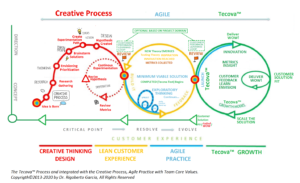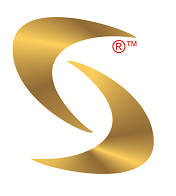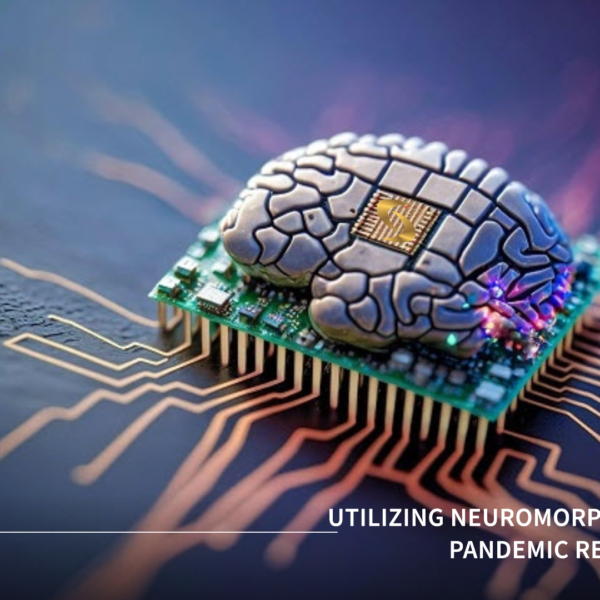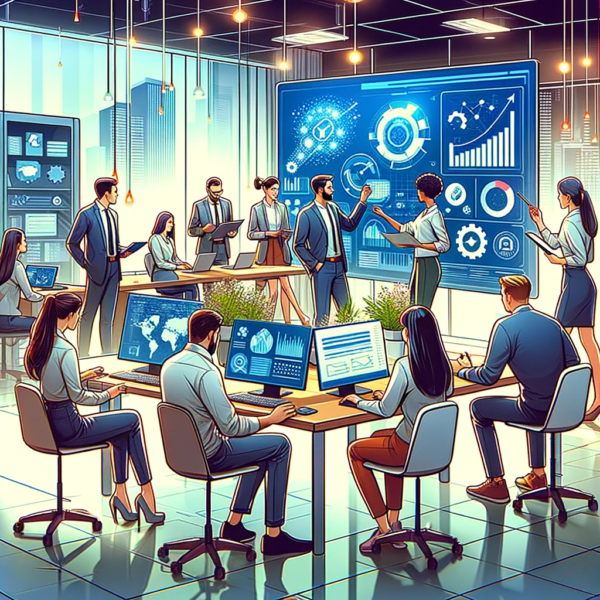Understanding the Agile-Tecova Practice
Agile Tecova Practice
The Agile Tecova Practice is a project management methodology that combines agile principles with a creative process to deliver innovative solutions, particularly in software development. This approach aims to foster teamwork, flexibility, client collaboration, and rapid feedback cycles, drawing on principles pioneered by Dr. Rigoberto Garcia since 2000.
Key Features
- Small Functional Teams: Agile Tecova emphasises the formation of small, self-sufficient teams with diverse skill sets that can quickly respond to changing requirements.
- Iterative Delivery: The practice involves continuous delivery of incremental updates, encouraging early testing and iterative client feedback.
- Creative Process: By prioritising team creativity over rigid structures, Agile Tecova seeks to harness collective innovation rather than relying on individual contributions alone.
- Client Collaboration: Clients are involved at every stage, providing insights and ensuring the final product aligns with their needs.
Core Values
The methodology integrates several core values such as delivering exceptional results, embracing change, fostering team growth, and maintaining ethical integrity. These values are encapsulated in the “Tecova Process,” a conceptual framework guiding team behaviour and project execution.
Impact and Adoption
Agile Tecova has gained traction among creative professionals, including software developers, writers, and artists. It encourages innovation by blending flexibility with a structured framework that removes roadblocks to creativity. Teams using this methodology often report improved morale, increased adaptability, and more client satisfaction.
References
The Agile Tecova Practice and its foundational values are elaborated in the series of books authored by Dr. Rigoberto Garcia, available on his website and through Lulu Publishing. Further information about the Tecova Practice is provided through the corporate website, Software Solution Corp.
Team creativity in an Agile Tecova Practice
Agile concept can be utilized in any type of project. Most often when someone interacts with an Agile practice is thru some type of software development project.
When we are trained into an Agile practice, we seldom hear about maintaining the creative process of our Team intact. Its true, in Agile the Team lots of scope and flexibility in can at times lack creativity.
To help you understand this new Agile approach, let me first introduce you to the Agile process. Essentially the Agile process is characterized with the following features:
- Small functional teams that can
- Deliver faster solutions with less turnaround
- Ability to make decision amongst the team
- Testing early
- Delivering early
- Encourage feedback at every step of the way.
- Agile practice features
- Small teams
- Everyone’s ideas are valid
- Skills come from the Team not an Individual
- Brainstorming
- Team comes up with the ideas
- Team picks the best viable idea
- Team presents the idea to a client
- Once the client approves, prototype phase begins
- Client give feedback
- The work begins
- Agile Process
- Steps repeated at every phase until the client has a product
- Client is completely satisfied
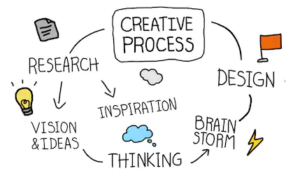
In my opinion Agile is a Creative process. Most people think “creativity” is independence from structure, freedom from authority, and I believe that perception to be ineffectively wrong.
Some scientific studies have shown, “rigorous task and structured contributing to the failure of creative projects”, however, in my opinion this is only due to the inability to manage road blocks within the Agile process. I would safely contribute the failure to stress rather than the structure of the creative project as the failing point. For example, an Artists, a writer and a creative professional may make the assertion that “rigorous tasks or structures will make it more difficult for them to innovate”, however, I attribute their comment to a basic lack of understanding of what an Agile creative process really is, everything else is just a bunch of hogwash.
In an Agile practice the creative process is only hinder if, structure blocks the team’s ability to innovate thru unreasonable request. For example, all changes must first be approved by a solutions architect; in this scenario the process is confronted with road blocks which impede the natural flow of ideas and a safe environment in to which express them.
We must all remember in immutable fact, we are humans. As such, our lives are directed by external and internal rules, some which cannot change; for example, must pay the electric of it is cutoff, must eat and drink, we must observe social distancing, we must wear a mask in public – Covid-19 Pandemic restrictions – or become weak, sick and die. Human life if full of restrictions. A Team in a middle of a brainstorming session still has to go to the bathroom. The problem is how we perceive creative freedom.
The facts are that none of us likes strict schedules, or unreasonable deadlines, however, we all benefit from small tasks and organized charts. Some feel that even this is a hindrance of the creative process; however, is it really? In over twenty-four years of utilizing the Agile practice to manager small and large projects in a diversity on industries a scenario, I do not see this as being true.
True creative work can benefit from Agile Creativity if done correctly, it’s not focused on pure, unbounded creativity. Essentially, Agile Creating Project Management Approach™ (ACPMA copyright ©2000 by Dr. Rigoberto Garcia) is an intense, responsive and fast-paced project management approach that’s usually applied to software programs, writers, artist, creative studios and every other project domain available.

The characteristics of agility are ideal in a creative environment. Why? Because the characteristics of agility:
- that of flexibility,
- fast turnaround time,
- client feedback etc.
are all part of all the components need if we are to create an effective project and support creative in any project’s domain.
Use structure to unleash creativity
As I said previously the characteristics of agile all concrete helps in developing creative projects. Creativity within a project are a work in progress, based on assumptions. Having rapid feedback from the customer is gold to the creative mind, this way you know how good your direction is and are able to adapt accordingly.
This also means a better support from stakeholders, in good times and also bad times. Regardless of the feedback a creative mind or team will always find a way to innovate.
What Agile project management gives us is structure to canalize creativity. If you combine Agile practice with a creative structure in your company, you’ll obtain an optimized way of working and a happy and inspired team of member to follow these basic practices, which will lead them to:
- Responds to change instead of following a strict functional plan
- Big-bang innovation integrated to Rapid iterations
- Team opinions and conventions while gathering Data and Testing
- Large and Small experiments
- Team interactions
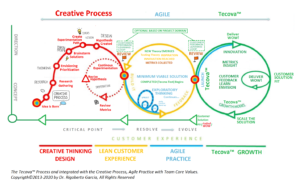
Figure 1.1: The Tecova™ Process (Team Core Values) integrated with the Creative Process and Agile.
Additionally, you will be able to integrate and follow other values, which enable creativity by extending our teams core values, for example, we have created a set of values for our team member to manager a diversity of projects in multiple domains, here are some of those values which we call Tecova™ values:
- Tecova™ Teams Core Values (beyond Zappos)
- Deliver WOW!
- Not a Job, a life style
- Not a Service, rather a Commitment
- Not a task, rather a Solution
- Embrace and Drive Change
- Weird can be fun
- Be Adventurous,
- Take Risk through experimentation
- Creative
- Through a Team Effort
- Be Open-Minded
- To all solutions
- Pursue Growth and Learning
- Build Open and Honest Relationships
- Communication
- Experimentation
- Education
- Build a Positive Team
- A Family instead of Employees
- A Home instead of Brick and Mortar
- Do More with Less
- Be Passionate
- Your Work
- Your Team
- Your Family
- Encourage determination
- Be ethical and Honest
- Be humble and yet proud
- Deliver WOW!
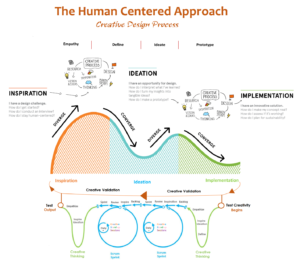
Creative innovation rather than stale collaboration.
Talent, knowledge and skill are not enough to achieve business success, especially when it comes to shooting for big, ambitious goals. For today’s business leaders and entrepreneurs, it’s about learning how to make the most of their business brainpower, develop their innovation and decision-making capability and tap into the creative potential of their network of contacts. It is also about being able to influence with integrity to make things happen, make progress quickly and respond to changes and opportunities.
John and Beth are software developers on a team charged with creating an on-line system through which customers and vendors could access vital information about certain opportunities. It was critical that the new system be error-proof because the targeted audience were executives; which could have a negative impact on the revenue of the business. Accurate information about had to be presented and communicated in a simple manner over multiple languages, platforms and devices around the globe. Unfortunately, the original contract for the project had vastly underestimated the time required to develop it. As a result, Beth and John, along with their team found themselves under extreme time pressure and the deadline was approaching fast.
The team was working almost around the clock, even though it was becoming clearer with each passing day that the complex technical problem it encountered simply could not be solved adequately within the time frame using the current toolsets. Yet senior management, as well as the project leader, pressed the team to meet the deadline, no matter what. Does this sound like a familiar scenario?
John and Beth, decided to allow the team to find a solution. In the next standup meeting, John and Beth discussed in an open forum with the team the time constrains encountered and encourage the team to find a better way, without having to rewrite or increase the complexity of the solution. The team was given 45 minutes to discuss openly the project and the constrains, in that time several new opportunities were identified, including hosting the application on the Microsoft Azure Cloud and utilizing a Cosmo Database instead of a SQL Server instance they were using.
While the team was still in discussion looking for a solution, Mike the lead cloud architect open Azure Portal, and app service sandbox, connecting it directly to their private GitHub. In a manner of 15 minutes the entire code base was in Azure and the application test was live. As a single entity the team made the decision to change deployment models and tasked Beth and John to present the changes to management and the product owner.
The outcome was favorable, the team was able to avoid a project failure and delivered a better solution to the customer.

Why was this possible? The creative process of the team was not hindered with rules. Both, John and Beth understood that solutions seldom come from an individual rather from a team collective. They gave the power of choice to the team, they were able to find a solution, that met the need of the team, product owner and stakeholders. Additionally, because the used the human centered approach which had been modified to serve the creative process, they were able to provide a solution rather than be frustrated potentially contribute to project failure.
Setting unrealistic project goals amidst a pandemic?
During a time of crisis, it is difficult to operate an enterprise traditionally. Amidst the uncertainty which is surrounding us today, companies face challenges – from managing communications and crisis response planning, to maintaining some level of continuity of business operations.
The Agile practice can be a unifying factor for staff and teams, since they can focus on common goal of that will serve their corporate family, and strengthen the loyalty bonds of team members. The creative process and utilization of Tecova and Zappos will inspire and enable everyone to refocus during a crisis. Maintaining the organization’s operations and support the creativity of our teams. The Agile practice can be use to respond, quickly to the creative need of the team members, also offers some of the safety, normalcy, and comfort that we all need, amidst difficult times, which otherwise would usually find in the routine of daily life at work.
As corporate process begins to move toward remote utilization of our teams, it is important to continue the nurturing of the Agile Practice and prevent fractioning the harmony of our teams and their members. This means that many organizations are currently reassessing their feedback strategy and will need to weigh in on a variety of factors, for this reason, including the Agile practice will benefic the organization, in order to meet their unique organizational needs.
Over the last few months, we have heard of organizations deciding to either delay or abandon portions of their Agile practice or even hindering the creative process in order to enforce more strict structures, this is a functional mistake. We must remember, we must fail at times to be creative.
WHY MUST GREAT IDEAS FACE REJECTION?
The explanation is simple, uncertainty makes people squeamish, and creativity and uncertainty go hand-in-hand. “Creativity involves uncertainty because it is difficult to know the consequences of something truly new,” writes Seana Moran, psychology professor at Clark University in The Cambridge Handbook of Creativity. “The belief is that novelty makes a situation more uncertain for the rest of us, which gives rise to anxiety.”
New innovations are often rejected simply because people don’t have a point of reference for them. We resist what we don’t know, hesitating to put our faith behind breakthrough ideas, so that they often face what Leslie Ehm, founder of the firm Three Training, calls the “Rejection Conundrum.”
Research has backed this claim. According t
What’s the main benefit of agile creativity for projects and teams?
Creative projects always bear the risk to be rejected in the end by the decision maker (stakeholder, client, manager,…). This is normal, it becomes a problem when you get the rejection in the end, when a great part of the effort is already done.
Agile will help you avoid this by making you present working prototypes of your design or content within short iterations. This way, you get feedback as early as possible and can adjust your work accordingly.
So how do you apply Agile Project Management to a creative team? In three steps:
